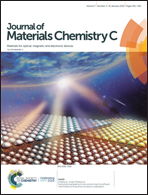Understanding the blue-emitting orthoborate phosphor NaBaBO3:Ce3+ through experiment and computation†
Abstract
An orthoborate phosphor with the composition, NaBaBO3:Ce3+, and the associated solid solution Na(Ba1−δSrδ)BO3:Ce3+, are obtained using high-temperature solid state synthesis. These phosphors produce a bright blue emission with a high internal (65%) and external (46%) quantum efficiency upon excitation using 360 nm UV light, as anticipated based on the crystal chemistry. Fabricating a device using a 370 nm UV-LED chip as the excitation source combined with NaBaBO3:Ce3+ as the blue phosphor, Ba3Si6O12N2:Eu2+ as the green phosphor, and CaAlSiN3:Eu2+ as the red phosphor, creates a high-quality white LED with a color rendering index (Ra) of approximately 90 and color correlated temperature (CCT) of 4143 K. Interestingly, these results are in contrast with the report of an unexpected green emission in NaBaBO3:Ce3+. Therefore, a combined crystal-chemical analysis and computational evaluation were conducted based on a crystal field theory (CFT) and density functional theory (DFT) to understand this discrepancy in the reported emission colors. The results indicate the probable origin of the different optical properties in this phosphor stem from the rare-earth ion substituting on different crystallographic sites. The combination of computational modeling and experimental chemistry provide unequivocal evidence for the relationship between the crystal structure and the observed optical properties in rare-earth substituted phosphors.



 Please wait while we load your content...
Please wait while we load your content...